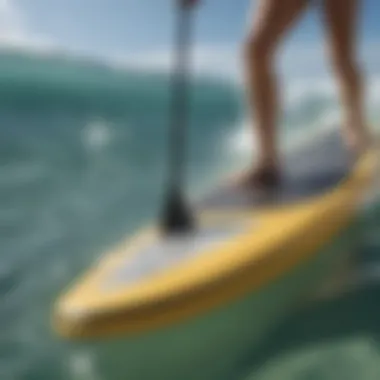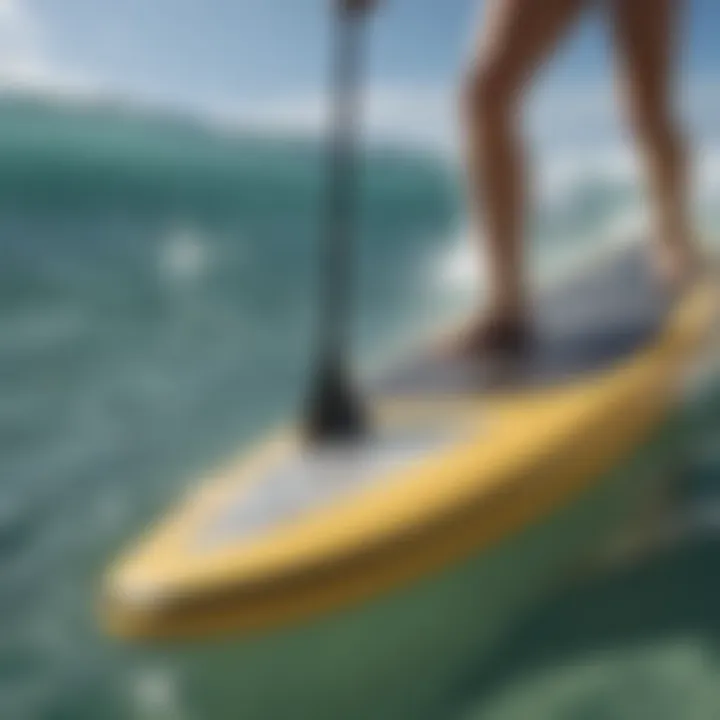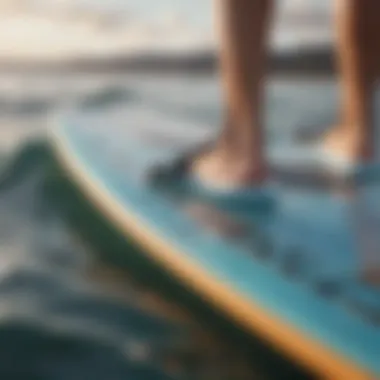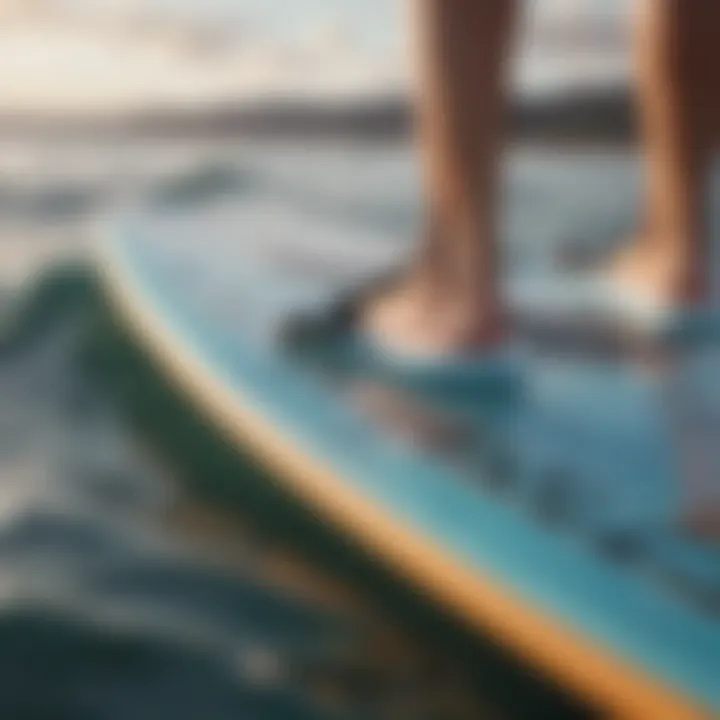Exploring Fit Wave Stand Up Paddle Boards


Intro
In the realm of water sports, the advent of fit wave stand up paddle boards has changed the game for enthusiasts and novices alike. These boards offer a fusion of stability and performance, suited for various experiences on the water. Understanding their design and functionality not only enhances the paddling experience but also promotes safety and joy while engaging with the ocean.
This article aims to serve as a compass for those seeking knowledge about fit wave paddle boards. Whether you’re riding gentle waves or cruising on flat waters, making informed decisions is paramount. From dissecting the physical attributes of these boards to diving into critical maintenance practices, we leave no stone unturned. Additionally, we explore how these boards impact the broader surfing culture and global conservation efforts.
The following sections will provide clarity and depth into what makes fit wave paddle boards a preferred choice, including their suitability for varying skill levels and environmental conditions. By the end, you’ll not only understand how to select the right board but also appreciate its role within the larger water sport ecosystem.
Prelude to Fit Wave Stand Up Paddle Boards
Stand Up Paddleboarding, often known simply as SUP, has witnessed a meteoric rise in popularity over the past decade. This engaging water sport combines elements of surfing and kayaking, giving paddlers an exhilarating way to connect with nature while enjoying various water environments. Within this realm, Fit Wave stand up paddle boards have carved out a significant niche, attracting surf enthusiasts and casual paddlers alike. Understanding Fit Wave boards is essential for those looking to optimize their experience, whether that’s gliding across calm waters or tackling a challenging wave.
Fit Wave paddle boards are crafted with specific features that cater to all skill levels, ranging from beginners learning the ropes to seasoned pros tackling the curls. They typically boast characteristics that enhance stability, maneuverability, and overall performance in various conditions. Therefore, having a solid grasp of the nuances, such as design aspects and performance metrics, is vital. This section aims to provide an insightful overview that will serve as a foundation for the discussion of these specialized boards throughout the article.
Defining Stand Up Paddleboarding
Stand Up Paddleboarding is more than just standing on a board and paddling; it’s a diverse activity that combines exercise, adventure, and serenity. Originating from Hawaii, where ancient surfers would paddle out to catch waves while standing, this sport has evolved to encompass various styles and disciplines across the globe. From leisurely flatwater paddling to extreme surfing situations, SUP offers something for everyone.
The core of this activity lies in its accessibility. Unlike traditional surfing that demands specific wave conditions and board types, paddle boarding can be pursued in a variety of water bodies, including lakes, rivers, and oceans. Essentially, anyone with a board and a paddle can embark on an adventure, making it a popular choice among families, fitness enthusiasts, and thrill-seekers. The personal connection to the water and nature often leads paddlers to foster a deeper appreciation for their surroundings, which is an incredibly rewarding aspect of this sport.
The Rise of Fit Wave Paddle Boards
In recent years, Fit Wave paddle boards have surged in popularity, riding the wave of the broader SUP trend. The allure of these boards can largely be attributed to their meticulously engineered design aimed at performance and versatility. Unlike other boards that may be single-purpose, Fit Wave boards strike a balance between stability and agility, making them suitable for both flatwater paddling and surf sessions.
Their construction often incorporates cutting-edge materials, optimizing them for durability without sacrificing weight. Paddlers appreciate the responsiveness these boards offer when navigating challenging conditions, allowing for a smooth transition from learning how to paddle to expertly navigating waves.
Furthermore, the social aspect of paddleboarding producted a community that rallies around these boards. Events, meetups, and competitions pop up regularly, fostering camaraderie among paddleboarders. This collective enthusiasm fuels the growth of the sport and the demand for Fit Wave models.
Overall, understanding the unique characteristics of Fit Wave paddle boards is crucial for prospective paddlers seeking the best fit for their needs, ensuring they choose a board that matches their skill level and intended use. Without a doubt, these boards have secured their place in the paddling world, symbolizing a blend of tradition and innovation that attracts a diverse range of enthusiasts.
Design and Construction
When it comes to stand up paddle boards, design and construction play a pivotal role in how effectively a board performs on water. The materials used, shape, and dimensions can greatly influence the overall experience an individual has while paddling. A well-constructed board ensures better durability, performance, and can guide a paddler, whether they are a novice or a seasoned pro, in achieving their desired activities on the water.
Materials Used in Fit Wave Boards
Fiberglass
Fiberglass is a common material found in many paddle boards due to its excellent balance of strength, weight, and cost-effectiveness. One of the key characteristics of fiberglass is its ability to offer a lightweight, yet durable surface which is essential for maneuvering and speed on the water.
A unique feature of fiberglass is its capacity to be shaped into various designs, giving manufacturers the flexibility to create boards tailored for specific paddler styles. Moreover, fiberglass boards often come with a smooth finish, aiding in hydrodynamics, which enhances immersion into waves. However, they can be prone to dents and require a bit of care to keep them in top shape.
Epoxy
Epoxy boards, another front-runner in this field, have been growing in popularity for their powerful attributes. The key characteristic here is the ability to sustain high-performance racing with minimal weight added. Epoxy resin, when baked with the board, provides a significant boost to rigidity and lightness, which is crucial for serious athletes pushing their limits on Fit Wave boards.
A unique feature of epoxy is its resistance to water absorption, which means it performs better over time, particularly in harsh environments. On the flip side, epoxy boards can be more costly, and some paddlers find them less forgiving when dealing with rough waters as they may feel stiffer.
Inflatable Options
The introduction of inflatable options has revolutionized paddle boarding, making it accessible for all. The key benefit of inflatable boards lies in their portability. They can be deflated for convenient storage, making them an ideal choice for those who are short on space.
One unique feature of inflatable boards is their construction, often comprising multiple layers which not only enhance durability but also improve stability on water. The downside is that some may find them less responsive compared to hard boards, especially in wave riding situations, but they can offer a cushioning effect when compared to rigid options.
Shapes and Dimensions
Length Considerations
Length is a decisive factor when selecting a paddle board. Longer boards generally glide better, making them suitable for straight paddling in calm waters. The key characteristic here is that they offer increased tracking ability, which means less effort to keep the board moving straight.
However, the unique feature of shorter boards is their enhanced maneuverability. They allow for sharp cuts and turns, making them appealing for surfers looking to catch waves. With this balance in mind, the choice ultimately comes down to the paddler's intended use—whether it’s leisurely paddling or an adrenaline-pumping wave ride.
Width and Stability
Width is another consideration that significantly impacts stability. Wider boards provide both balance and added area in contact with water, resulting in a more stable ride, particularly for beginners. The key aspect of a wider board is that it aids in preventing falls while improving confidence for novice paddlers.


The unique feature of narrower boards, while less stable, allows for greater speed and agility, appealing to experienced surfers who prioritize performance over stability. This trade-off is essential in guiding paddlers towards a board that complements their skill level and objectives.
Thickness and Volume
The thickness and volume of a paddle board play a crucial role in its buoyancy and overall performance. A thicker board can handle larger paddlers or gear, allowing for more weight without compromising stability. The key characteristic of volume is related to a board's overall buoyancy; higher volume means more lift, which is favorable in diverse water conditions.
On the contrary, boards with lower volume tend to have a sleeker profile, benefiting speed enthusiasts who seek a competitive edge. The unique aspect of choosing the right thickness involves balancing buoyancy needs with paddler weight and intended use, ensuring the selected board aligns comfortably with the paddler's physique and activities on the water.
Performance Analysis
When it comes to stand up paddle boarding, how well a board performs can make or break the experience. Performance analysis isn't just a technical exercise; it’s essential for understanding how to get the most out of a fit wave paddle board. This section delves into key elements like paddling efficiency and wave riding capabilities that help paddlers make informed choices about both the board and their skills. Performance metrics are critical, as they translate into practical benefits, like better glide or the ability to ride waves effectively, which can enhance both enjoyment and safety.
Paddling Efficiency
Tracking and Glide
Tracking and glide are two sides of the same coin in paddle boarding efficiency. Tracking refers to how straight a board moves through the water, while glide is about how far it can go with each stroke. A board that has superior glide allows paddlers to make fewer strokes and cover more distance, which is vital, especially during longer trips. A well-designed fit wave paddle board typically exhibits a sharp nose, a streamlined shape, and a hull that promotes minimal drag. This makes tracking and glide seamlessly blend into the user experience.
For instance, boards with a pointed nose will cut through water more effectively, while a wider tail will provide stability. While this configuration makes for a generally excellent choice, it’s important to consider that not all paddlers may prefer this style of board. Some may find that a wider board offers more stability at the expense of glide.
"Great tracking and glide mean fewer strokes and more fun on the water."
Turning Maneuverability
Turning maneuverability is another critical factor in performance analysis. This describes how easily a board pivots and changes direction. A board can be efficiently designed for speed but may lack agility. For example, shorter boards generally excel in turning quick, making them ideal for surfers who wish to navigate challenging waves. Longer boards, while great for a straight line glide, may feel clunky when trying to execute sharp turns. The shape of the board, particularly the tail, plays a vital role in this.
A fit wave paddle board with a swallow tail design will often provide better turning abilities, allowing the paddler to navigate effortlessly, which is particularly beneficial in surf conditions or crowded waters. In balancing the choice for a fit wave board, paddlers must weigh stability against agility, as what works for one situation may not fit another.
Wave Riding Capabilities
Best Waves for Fit Wave Boards
Selecting the right wave conditions for fit wave boards is paramount. Different boards excel with different wave types, so knowing which waves are best suited is crucial for performance. Typically, smaller, less aggressive waves are ideal for beginners using fit wave boards, allowing for a gentler introduction to the sport. In contrast, intermediate or advanced paddlers might seek out more powerful surf to challenge their skills.
Fit wave paddle boards can hold their own in choppy waters, but not all are created equal. Boards designed explicitly for wave riding often feature a narrower profile and a thruster fin setup, particularly effective in carving out turns on steeper waves. However, while challenging conditions can be exhilarating, they also require a proficient paddle technique to keep the session enjoyable.
Techniques for Wave Riding
Paddle boarding isn't just about standing on a board; it’s a mix of skill and technique. Techniques for wave riding often include advanced maneuvers like cutbacks or bottom turns. Understanding the nuances of these movements greatly contributes to how effectively one can handle waves. For instance, a cutback involves turning the board to return to the breaking wave after initially riding it away. Mastering this skill increases a paddler’s control and awareness of their surroundings.
Additionally, learning proper stance and balancing methods—like keeping your knees slightly bent and positioning your feet shoulder-width apart—can dramatically improve performance when catching waves. While they may take some time to master, these techniques provide a rewarding experience on the water.
In summary, performance analysis is crucial to understanding the criteria that affect your time on a fit wave paddle board. Paddling efficiency through tracking, glide, and turning maneuverability, as well as techniques for harnessing wave riding capabilities enriches the overall experience, empowering paddlers to make educated decisions as they navigate thriving waters.
Choosing the Right Fit Wave Paddle Board
Selecting the appropriate fit wave paddle board is more than just a matter of preference; it holds significant weight in determining your overall experience on the water. The board you choose should resonate with your skill level, size, and the environment in which you plan to paddle. Navigating these considerations can enhance your performance and safety on the water, ultimately making your paddleboarding journey more enjoyable. Understanding the nuances of each factor is essential to ensure your time spent on the paddle board is both productive and fulfilling.
Skill Level Consideration
When choosing a paddle board, it’s crucial to evaluate your skill level. Beginners may prefer wider, more stable boards that are easier to balance on, while advanced paddlers often opt for narrower designs that allow for swifter movement and better responsiveness. Choosing a board that aligns with your proficiency can make all the difference. If you’re new, you might want to look at models like the Fit Wave Discovery Board, which provides stability for those still learning the ropes. Conversely, seasoned surfers might favor the Fit Wave Performance Board, which offers agility and speed for those more comfortable on the waves.
Weight and Size Factors
Another key aspect is the physical attributes of the individual paddler. Weight plays a pivotal role in determining which board will provide optimal performance. Heavier paddlers may require boards with a higher volume to ensure buoyancy and sufficient support. It’s also important to consider height and body dimensions. For instance, shorter individuals generally do well with smaller boards that they can maneuver easily, while taller paddlers might benefit from larger, broader designs.
- Buoyancy: Make sure the volume of the board matches your weight for stability.
- Length & Width: Choose the dimensions that align with your paddle style, be it racing or leisure.
Paddling Environment
The environment in which you plan to paddle is a decisive factor in the choice of your fit wave paddle board. Different conditions demand different board characteristics, and understanding how these will affect your experience is important. Here's a look at two vastly different scenarios that every paddler should consider:
Calm Waters vs. Rough Seas
Paddling in calm waters typically calls for a board that prioritizes stability and ease of use. Flat, serene lakes or slow-moving rivers allow for leisurely paddling, enabling users to focus on technique without the distraction of turbulent waves. In these settings, boards like the Fit Wave Leisure Cruiser become increasingly popular due to their wide shape, allowing for an easy, smooth ride.


On the other hand, navigating rough seas requires a board that can withstand the impact of waves and chop. Here, durability and rocker shape become essential qualities. A board such as the Fit Wave Adventure Board, designed with a tapered nose, allows for better cutting through the rough conditions.
"The environment often dictates the experience. Understanding what kind of waters your board is suited for is half the battle."
Flatwater vs. Surf
Lastly, the choice between flatwater and surf settings even further defines what board might be best suited for your paddling style. On calm, flat water, a longer board can facilitate a more efficient stroke and increase speed, enabling you to cover greater distances with less effort. The Fit Wave Touring Board shines in these conditions, giving the paddler a smoother ride for longer adventures.
In contrast, surfers need a more agile board that can handle waves and quick turns. Boards like the Fit Wave Surf Pro are tailored for those riding swells, allowing for sharper navigation and bursts of speed to take on the waves confidently. Each type of water presents unique challenges and opportunities, making your choice crucial to your paddleboarding success.
Paddle Boarding Techniques
Paddle boarding isn't just about gliding across the water; it's an art of finesse and skill that evolves with every stroke. Understanding paddle boarding techniques can significantly enhance your experience on Fit Wave stand up paddle boards. The right techniques allow paddlers to travel efficiently, ride waves adeptly, and minimize the strain on their bodies. Whether you're a novice looking to grasp the basics or a seasoned rider aiming to refine your maneuvers, mastering these techniques is pivotal.
Key elements to consider when diving into paddle boarding techniques include:
- Efficiency in Movement: A proper paddling technique can greatly reduce fatigue, allowing you to enjoy longer sessions.
- Wave Riding Mastery: Knowing how to maneuver effectively on waves can make the difference between an exhilarating ride and a frustrating one.
- Safety Awareness: Familiarity with techniques helps in anticipating conditions and reacting appropriately, which can avoid mishaps.
Focusing on basic skills fosters a solid foundation, while advanced maneuvers can elevate your paddling from simple recreation to something that could impress even a veteran surfer.
Basic Paddling Skills
In the realm of stand up paddle boarding, establishing basic paddling skills is like laying the first brick in constructing a sturdy house. These skills include the grip on the paddle, stance on the board, and the very motions you make while paddling. A solid grip on the paddle helps in generating power without unnecessary strain. Your stance on the board - feet shoulder-width apart and a slight bend in the knees - aids in balance and stability.
Beyond the stance, a consistent stroke is pivotal.
- Entry: This is the moment when your paddle first meets the water.
- Catch: Pull the paddle so it's fully submerged; maximizing the power.
- Pull: This is the heart of your stroke where your core and shoulders drive the motion.
- Exit: Pull the paddle out of the water without splashing, transitioning smoothly into the next stroke.
These steps, when practiced regularly, can instill a rhythm and flow to your paddling and lead to improved speed and efficiency.
Advanced Maneuvers
Once basic skills are down, it's time to step up to advanced maneuvers that can significantly enhance your experience on the waters. Advanced techniques require a developed instinct and body control that might take some time to hone. Two notable maneuvers worth delving into are cutbacks and carving turns.
Cutbacks
Cutbacks are a brilliant maneuver that allows the paddler to regain momentum and position while riding a wave. They are crucial for surfers seeking to make the most out of their waves. What sets cutbacks apart is the seamless transition from riding forward on the wave to quickly redirecting back toward the pocket. This not only maintains speed but also adds a graceful flair to the ride.
The main attractiveness of a cutback lies in its ability to showcase style while also ensuring you stay in the wave’s energy zone. Practicing cutbacks can raise your confidence levels in the water and enhance the overall thrill of paddle boarding. However, they require precision; without proper execution, they can lead to losing momentum or potential wipeouts.
Carving Turns
Carving turns are the bread and butter of advanced paddle boarding maneuverability. This technique allows paddlers to lean into their turns, creating arcs that propel them with speed while maintaining their balance. The magic of a carving turn is in its fluidity; it's a dance between the board and the water, as your bodyweight shifts seamlessly from one side to another.
The key characteristic of carving turns is its emphasis on body mechanics. By engaging your core and using your legs, you can create sharp, controlled turns without losing speed. The major advantage here is the excitement it brings, as it aids in navigating through waves with instinctual control. However, one downside could be that improper weight distribution can cause instability, posing a risk for falls.
In summary, mastering paddle boarding techniques enhances your experience on Fit Wave paddle boards. From the basic skills that form your foundation to advanced moves that add flair to your style, every aspect contributes to becoming a proficient paddler. Like a seasoned mariner, with practice and dedication, you can navigate the waters with grace.
Maintenance of Paddle Boards
When it comes to paddle boards, maintenance plays a pivotal role in ensuring long-term performance and enjoyment. These boards are exposed to varied environments — be it sun, saltwater, or fresh lakes. Regular upkeep not only prolongs the lifespan of your Fit Wave paddle board but also optimizes its functionality. Focusing on proper care can prevent costly repairs and enhance safety on the water.
Cleaning Techniques
The first line of defense against wear and tear is proper cleaning. After each session, rinse off your board with clean water. Not just spray it liberally; think of it as wiping off the daily grime, including sand, salt, and debris. Pay special attention to the non-slip deck areas where sand can settle and create a hazard during your next ride.
When it comes to deeper cleaning, avoid harsh chemicals. A mild soap and soft sponge can do wonders. For those stubborn marks that seem like they’re there to stay, a soft scrub brush may be necessary. The trick is to always dry the board completely before storage; otherwise, you run the risk of water damage or mold growth.
Storage Recommendations
Storing your paddle board correctly is just as essential as cleaning it. Ideally, keep it in a cool, dry place, out of direct sunlight. UV rays can degrade the materials over time, leading to cracks or fading. If you have the luxury of space, consider hanging your board on a wall. Not only is this space-efficient, it's also a great way to show off your love for paddle boarding.
If wall space isn’t an option, you can lay it flat on a padded surface covered with a tarp. Just stear clear of uneven ground, as this may warp the shape. Alternatively, investing in a dedicated board bag can shield your paddle board from physical damage while keeping dust and moisture at bay.
Repairing Common Damages


Even with the best of care, accidents happen. It’s a part of paddle boarding, really. Knowing how to address common damages can save you both time and money.
Dings and Scratches
Dings and scratches may seem merely cosmetic, but they affect the board’s integrity. When you sustain a ding, it’s vital to repair it promptly; otherwise, you invite water intrusion, which weakens the material. Most boards come with repair kits that include resin and patches, so it’s beneficial to familiarize yourself with these tools.
The key characteristic of a ding is its invisibility until it’s too late. Brief, casual inspections might lead you to miss deeper cracks. The real takeaway here is that a small investment in maintenance can avert a larger financial burden later on.
Leaky Valve Issues
Leaky valve issues, particularly in inflatable paddle boards, necessitate immediate attention. A leak can disrupt your entire paddling experience, affecting buoyancy and stability. The primary concern here is identifying the source of the leak. Many times, it’s due to wear over time or improper inflation.
When faced with this situation, mark the area of the leak and apply a good quality repair adhesive designed for inflatables. While this may seem like an annoying bump in your paddle journey, fixing it is straightforward and can be done without much fuss. A valve that leaks reduces the board’s performance; and as a paddler, the last thing you want is an unstable ride.
Remember, regular maintenance not only keeps your Fit Wave paddle board in prime condition, but it also ensures your safety on the water. Invest a little time today for a more enjoyable paddle tomorrow!
In summary, maintaining your Fit Wave paddle board requires a bit of diligence, but the payoff is significant. With cleaning, storage, and repair strategies at your disposal, you can ensure that your board remains a reliable companion on your water adventures.
Safety Protocols
Safety protocols are critical when engaging with any outdoor water activity, and paddle boarding is no exception. Given the dynamic nature of water environments, understanding safety measures and employing the right equipment can mean the difference between a delightful day on the water and a risky situation. \n\nIn the context of fit wave stand up paddle boards, it’s imperative not only to enjoy the ride but to also consider safety gear and the impact of weather conditions. These elements can greatly enhance your experience while ensuring your well-being. \n\n--- \n> "Safety doesn’t happen by accident; it is a choice we make every time we set foot on the board." \n--- \n\n### Essential Safety Gear \n\n Life Jackets \nWhen it comes to paddle boarding, life jackets, or personal flotation devices (PFDs), stand as one of the most essential safety pieces of gear. A good life jacket offers buoyancy and help in case of an unexpected fall. They have come a long way and aren’t just bulky orange vests anymore. \n\nOne key characteristic of modern life jackets is their comfort. They are designed to allow for a full range of motion, crucial when paddling, while also being lightweight. Some even feature additional pocket space for small items. A life jacket that fits snugly can keep you safe without restricting your movements, making it a popular choice among surfers and paddlers alike. \n\nDespite their benefits, some may find life jackets cumbersome, especially in warm weather. However, advancements in technology have paved the way for lighter, more breathable materials, diminishing this concern significantly. \n\n Leashes \nLeashes play another significant role in paddle boarding safety. They serve as a direct connection between the paddler and the board, essentially ‘leashing’ the board to the rider. This becomes especially important when conditions get choppy or if a rider is knocked off. \n\nA distinguishing feature of leashes is their clutter-free design. Most leashes come with a coiled mechanism to minimize drag in the water, which can affect paddling efficiency. They are made to stretch, which also aids in flexibility while paddling. The common consensus is that using a leash can prevent your board from drifting away, making it easier to retrieve and less likely to injure other water users. \n\nWhile the benefits are clear, some users worry about entanglement issues if a leash isn’t fitted properly or if it gets snagged on something. Choosing the right length and attachment style can mitigate these risks effectively. \n\n Understanding Weather Conditions \nUnderstanding the weather can significantly dictate your paddle boarding experience. Wind speed, wave height, and water temperature are vital metrics that should not be overlooked. \n\nFor instance, an overcast day might seem calm but can easily disguise stronger winds or unseen currents. Being caught off guard by sudden weather changes could lead to serious accidents. Paddlers must be adept in reading the skies, understanding tide patterns, and gauging how conditions might change during their time on the water. \n\nSome practical tips include: \n- Check Local Forecasts: Always look at hourly forecasts before heading out. Websites like worldweatheronline.com can provide accurate updates.
- Look for Signs: Learning to recognize weather patterns, such as shifts in wind direction or cloud formations, adds an extra layer of preparedness.
- Stay in the Clear: If even small storms are in the vicinity, it's wise to postpone your outing. Safety should always come first.
By combining proper safety gear, understanding weather patterns, and keeping safety protocols at the forefront, paddlers are setting themselves up for an enjoyable and safe time on fit wave stand up paddle boards.
Environmental Considerations
When discussing fit wave stand up paddle boards, it's vital to explore the environmental ramifications linked with the sport. Paddleboarding can offer numerous benefits to paddlers, but its influence on marine ecosystems and natural resources cannot be overlooked. Understanding the impact paddling has on surrounding environments helps enthusiasts make informed decisions, ensuring they preserve the beautiful waters they enjoy.
Impact of Paddle Boarding on Marine Life
Paddleboarding often brings individuals closer to nature, providing an up-close experience with various marine species. However, this proximity can lead to unintended consequences for the delicate ecosystems. For instance, when boards glide across shallow waters, they can disturb habitats or push away fauna that is not adapted to such disturbances.
- Fish and Marine Mammals: Noise levels and turbulence created by boards may frighten fish or marine mammals. This is particularly true in areas where these creatures nest or feed. Paddlers should keep distance from these critical areas, hence minimizing disruptions.
- Coral Reefs: In regions where coral reefs flourish, careless paddlers might accidentally drag their boards over these sensitive structures, leading to damage that can take years to recover. It's important to learn and respect coral habitats, aiming to paddle in designated routes that steer clear of these marine treasures.
The environmental footprint of paddle boarding may not seem significant, but with many enthusiasts entering the water, collective behavior can lead to considerable stress on marine life. Keeping sights on the natural environments and altering paddling habits can help combat these impacts.
Promoting Sustainable Practices
With growing awareness about environmental conservation, promoting sustainable paddleboarding practices is paramount. Those drawn to the sport can adopt various methods to reduce their ecological footprint and encourage others to do the same.
- Choosing Eco-Friendly Boards: Consider investing in paddle boards made from sustainable materials. These boards often utilize recycled or eco-conscious production methods that lessen their overall impact on the planet.
- Leave No Trace Principles: This fundamental guideline urges outdoor enthusiasts to respect nature by cleaning up after themselves. Carrying a small bag to collect any trash encountered on the water or shoreline is a simple act that supports ecological health.
- Educate and Advocate: Share knowledge about the environmental impact of paddle boarding during practice sessions or community events. Engaging conversations can inspire fellow paddlers to initiate change. Social media platforms like Reddit and Facebook can serve as great tools to spread awareness.
In the long run, sustainable practices not only protect marine life but also enhance the entire paddleboarding experience, as clearer waters and thriving ecosystems create a better environment for all. Educating oneself and actively contributing to the preservation of natural spaces will ensure future paddlers enjoy the same beauty that draws so many to the water.
"Environmental stewardship is essential for enjoying what nature has to offer, without leaving a footprint that compromises its beauty."
Promoting these principles within the paddleboarding community encourages a collective responsibility that can significantly impact future generations. Together, enthusiasts can foster a close relationship with nature while ensuring that the waters remain vibrant and vital for all.
Cultural Significance of Paddle Boarding
Paddle boarding has rapidly transformed from a niche activity into a global phenomenon, significantly influencing various cultural elements. The sport is not just about gliding on a board over water; it embodies freedom, adventure, and a deep connection to nature. This section dives into the intricate tapestry of cultural significance surrounding paddle boarding, particularly as it relates to surf culture and global variations.
Paddle Boarding in Surf Culture
In many coastal regions, paddle boarding sits at the intersection of traditional surfing and new aquatic adventures. Originally developed as a means for surf instructors to oversee students and catch waves, paddle boarding has woven itself into the fabric of surf culture. Surf enthusiasts appreciate paddle boards as versatile tools that allow riders to explore less populated waters.
The connection to surf culture is palpable. Paddle boarding creates a collective experience, bringing people together on the water. Whether it's participating in a local race, a group sunset paddling, or even a community cleanup event, paddle boarding fosters camaraderie. Moreover, many surfers opt for paddle boards during flat days, thus maintaining a strong connection with the ocean year-round.
The aesthetic of paddle boarding often aligns with the laid-back surfer ethos. The boards come adorned with vibrant colors and creative designs, symbolizing a lifestyle that celebrates sunny days and because it embraces the beauty of the environment. This artistic expression is evident in events like paddle board art exhibitions and festivals, which elevate the boards to a medium of individual expression.
Global Variations and Trends
Paddle boarding has transcended its roots in Hawaii, now showcasing its adaptability across the globe. Each region has developed unique styles and trends, reflecting local cultures, waves, and environments. For instance, in the clear, tranquil waters of the Caribbean, paddle boarding is often coupled with snorkeling, allowing participants to explore underwater marvels. The boards often take on lighter materials and designs to accommodate the serene conditions, creating an entirely different paddling atmosphere compared to the waves of the Pacific.
Conversely, in places like Australia, paddle boarding aligns closely with the surfing lifestyle where competitive events thrive. SUP (Stand Up Paddle) racing has sparked a frenzy, drawing large crowds of both competitors and spectators, with numerous local events cropping up. Such competitions encourage a community spirit and contribute to a wider acceptance of paddle boarding in global sports.
Innovation marks the current trends in paddle boarding, with the introduction of inflatable boards gaining momentum. These boards are lighter and often more durable, making them appealing for travelers. The rise of eco-friendly materials also reflects a growing awareness of environmental sustainability as paddlers seek to lessen their ecological footprint.
Paddle boarding, therefore, is much more than a sport; it’s a culture that continues to evolve and adapt across the globe, reinforcing communities, promoting environmental consciousness, and celebrating individuality. As it stands today, there’s no doubt that fit wave paddle boards will continue to shape the cultural identity of future generations on and off the water.















